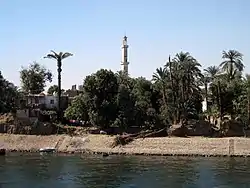Armant, Egypt
Armant (Egyptian jwnj, jwnj šm'j "Southern Heliopolis" or jwnj-mntw "the Heliopolis of the Nomad": (Coptic: ⲉⲣⲙⲉⲛⲧ or ⲁⲣⲙⲁⲛⲑ ˈərməntʰ) and known in Koine Greek as Hermonthis (Ancient Greek: Ἑρμῶνθις), is a town located about 12 miles south of Thebes. It was an important Middle Kingdom town, which was enlarged during the Eighteenth Dynasty. It is located today in the Luxor Governorate on the west bank of the Nile.
Armant
أرمنت | |
|---|---|
 Banks of the Nile at Armant | |
 Armant Location in Egypt | |
| Coordinates: 25°37′N 32°32′E | |
| Country | |
| Governorate | Luxor Governorate |
| Time zone | UTC+2 (EST) |
| • Summer (DST) | +3 |
History
| jwnw mnṯ(t)[1][2] in hieroglyphs |
|---|
| jwnw šmꜥ(t)[2][1] in hieroglyphs |
|---|
Montu was an Egyptian god whose root of name means "nomad".[3][4] Montu was associated with raging bulls, strength and war. He was also said to manifest himself in a white bull with a black face, which was referred to as the Bakha. Egypt's greatest general-kings called themselves Mighty Bulls, the sons of Montu.[5] In the famous narrative of the Battle of Kadesh, Ramesses II was said to have seen the enemy and "raged at them like Montu, Lord of Thebes".[6]
_I._Two_feet_of_a_female_figure%252C_at_the_right_side_of_the_right_foot_of_the_king._From_Armant%252C_Egypt.jpg.webp)
A temple dedicated to Montu existed at Hermonthis as early as the Eleventh Dynasty, which perhaps originated at Hermonthis. Nebhepetre Mentuhotep II is the earliest builder known with certainty. Important additions were made during the Twelfth dynasty and during the New Kingdom. Destroyed during the Late Period, a new temple was started in the reign of Nectanebo II and was continued by the Ptolemies. Cleopatra VII and Ptolemy XV Caesarion added a birth house with a sacred lake. The building remained visible until the nineteenth century, when it was recycled to build a sugar factory. Only the remains of the pylon of Thutmose III are visible today.
Two gates, one of them built by Antoninus Pius, have also been found. The Bucheum, the burial place of the sacred Buchis bulls of Hermonthis, is on the desert edge north of the city. The earliest bull burial dates to Nectanebo II, and the complex remained in use until the mid 4th century AD. The burial place of the Mother of Buchis cows has also been located. Extensive cemeteries of all periods are found in the neighbourhood of Hermonthis.
Under Cleopatra VII, Hermonthis became the capital of the 4th Upper Egyptian nome. The city remained in use during the Coptic era.
References
- Gauthier, Henri (1925). Dictionnaire des Noms Géographiques Contenus dans les Textes Hiéroglyphiques Vol. 1. pp. 54–55.
- Wallis Budge, E. A. (1920). An Egyptian hieroglyphic dictionary: with an index of English words, king list and geological list with indexes, list of hieroglyphic characters, coptic and semitic alphabets, etc. Vol II. John Murray. p. 958.
- Wallis Budge, E. A. (1920). An Egyptian hieroglyphic dictionary : with an index of English words, king list and geological list with indexes, list of hieroglyphic characters, coptic and semitic alphabets, etc. - Vol I. John Murray. p. 306.
- Ruiz, Ana (2001). The Spirit of Ancient Egypt. Algora Publishing. p. 115. ISBN 9781892941688.
- O'Connor, David; Cline, Eric H. (2001). Amenhotep III: Perspectives on His Reign. University of Michigan Press. ISBN 978-0472088331.
- "Egyptian Accounts of the Battle of Kadesh". www.reshafim.org.il. Archived from the original on 2011-12-01.